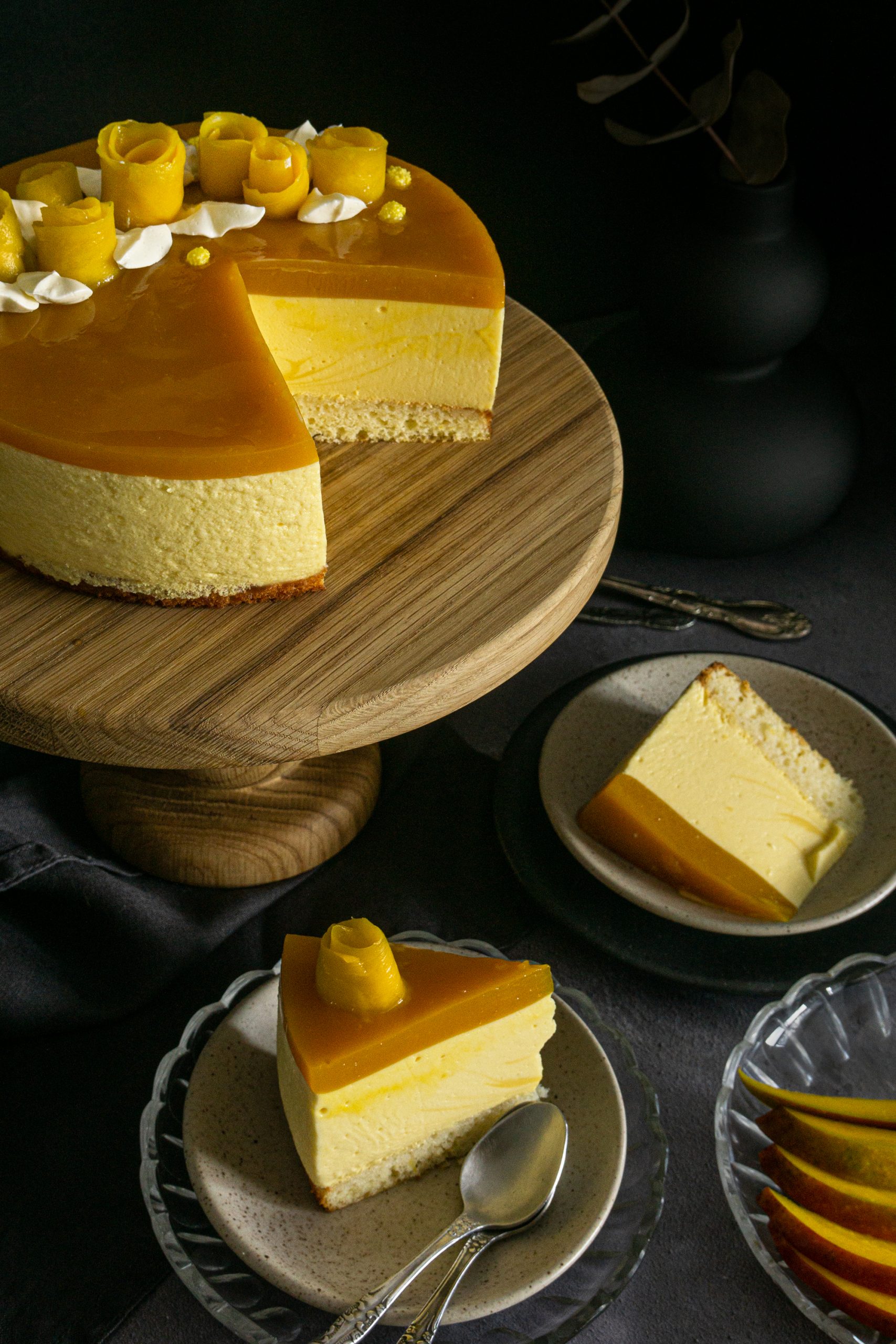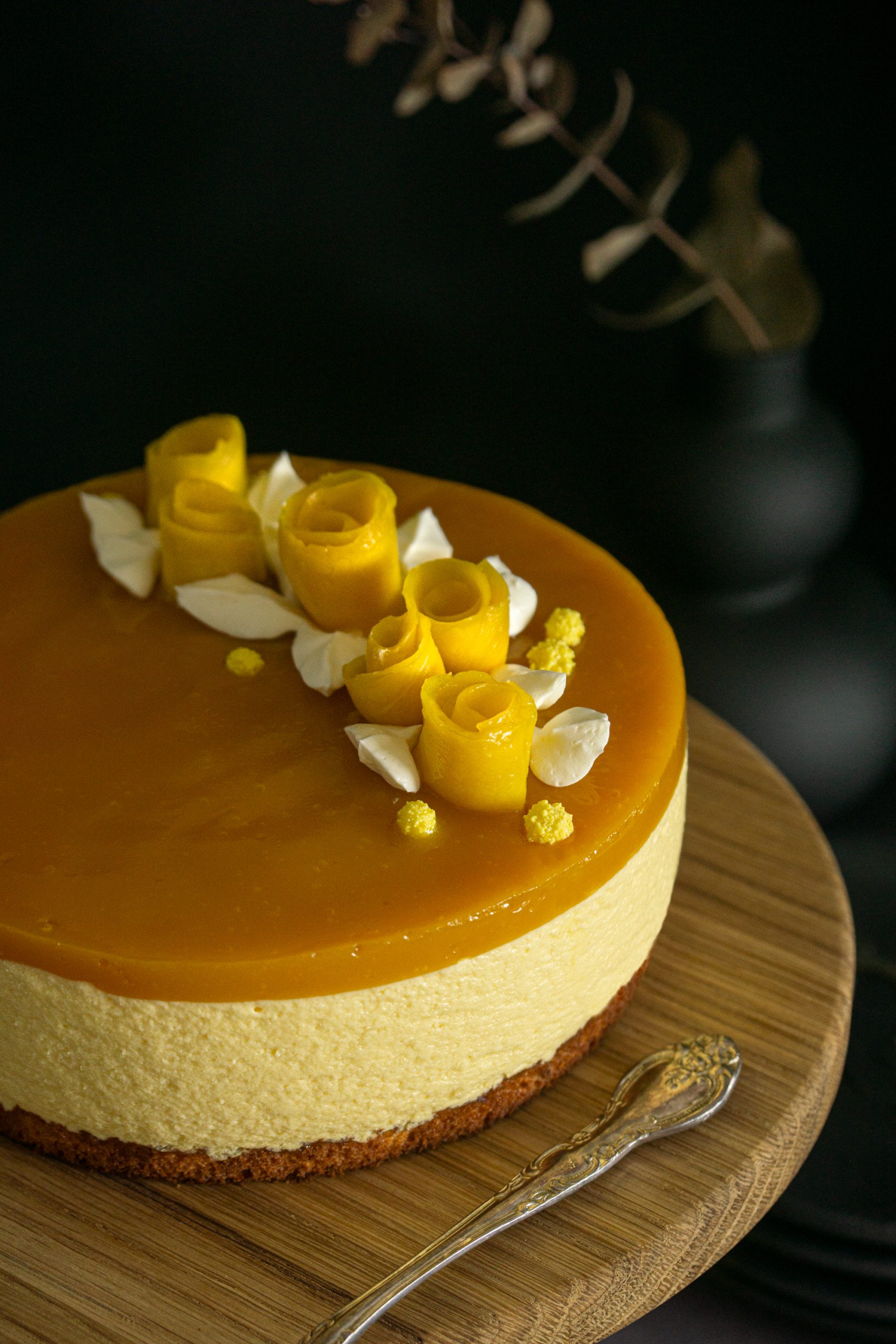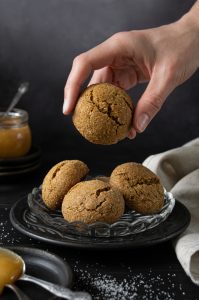Light as a cloud, soft and creamy, full of tropical taste, perfectly balanced in sweetness, and incredibly delicious. This mango mousse cake is a true summer dream. If you love mangoes, try this recipe, you will not be disappointed!
Easy to make
It’s one of the simplest layer cakes I have ever made and the result is fantastic. And who does not love a delicious dessert without adding a lot of effort when making it? Also, you don’t need expert decorator skills to make it look pretty.
Soft, light, and VERY delicious
Layered with a light lemon sponge, soft mango mousse, and fragrant mango jelly this cake is full of flavor and still so soft and airy, that every bite simply melts in your mouth. One piece is never enough. That’s why I ate half of the cake I photographed myself with no regrets!
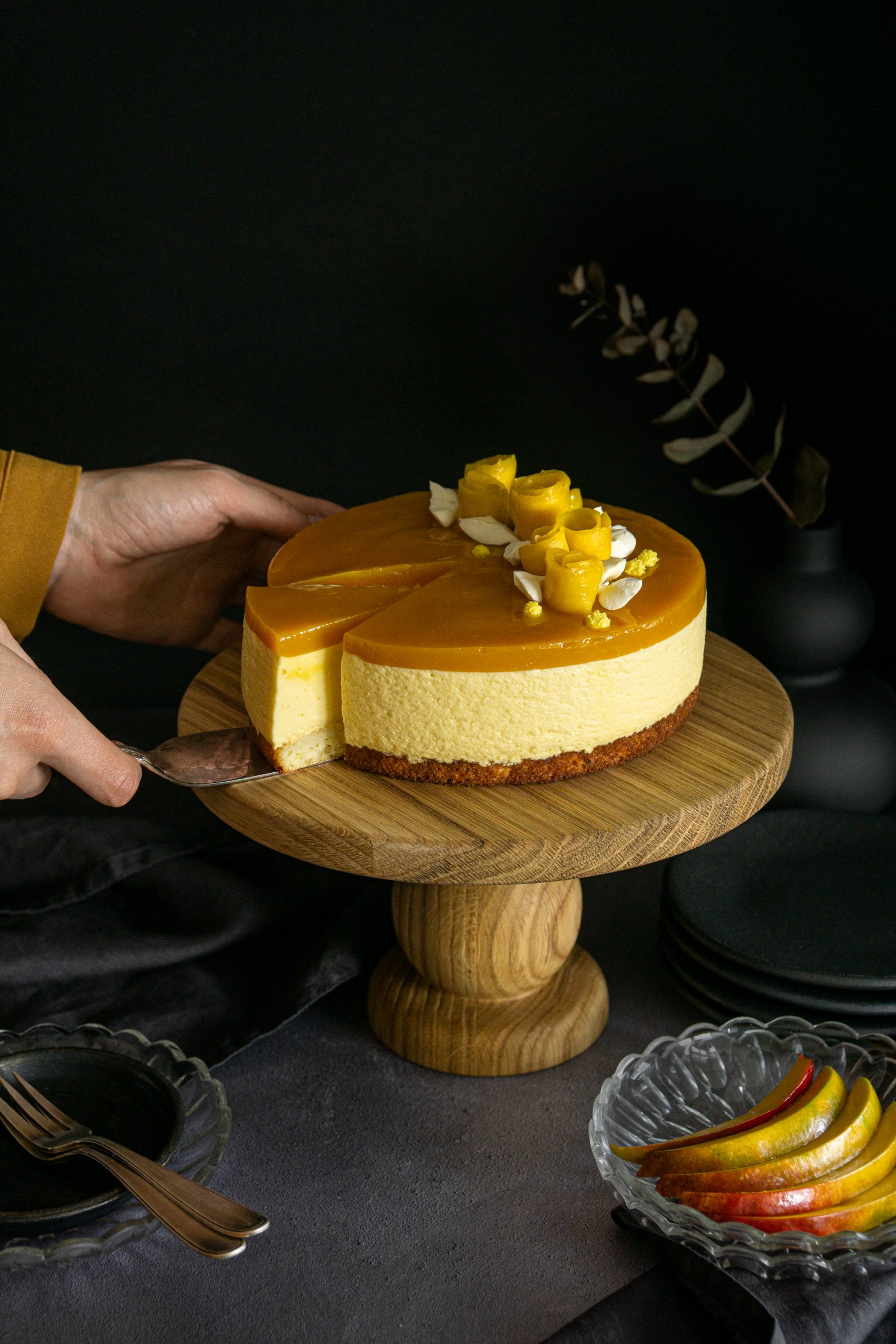
Good mangoes mean a tasty cake
The main flavor in this cake is, of course, mango. So it’s really important to use good, well-ripe mangoes. As usual, I tested different options and canned mangoes worked best for me. Because they are tasty, already peeled and sliced, which means less work! And they are more budget-friendly than fresh ripe mangoes (at least in this far north where I live). You can definitely use high-quality fresh mangoes if you prefer, but I don’t recommend using frozen ones. Yes, I tried. Yes, it was bad. Freezing damages cells and compromises taste, so you get less flavorful, not-so-sweet cake, that tastes like unripe mango.
Mango mousse with greek yogurt
The mango mousse in this recipe is enriched with some greek yogurt. I’ve tested 6 different mousse options: mousse with coconut cream, with cream cheese, with mascarpone cheese, with swiss meringue, with greek yogurt, and with whipping cream only. Yogurt added a bit of extra sourness that surprisingly made mango taste even stronger. That’s why this ingredient ended up in the final recipe.
Soft jelly layer
If you are not a fan of jelly cakes, no worries, I don’t like them either. The top jelly layer is made of mango puree, so it’s still soft enough to melt in your mouth easily and it makes this cake taste much more mango-ish.

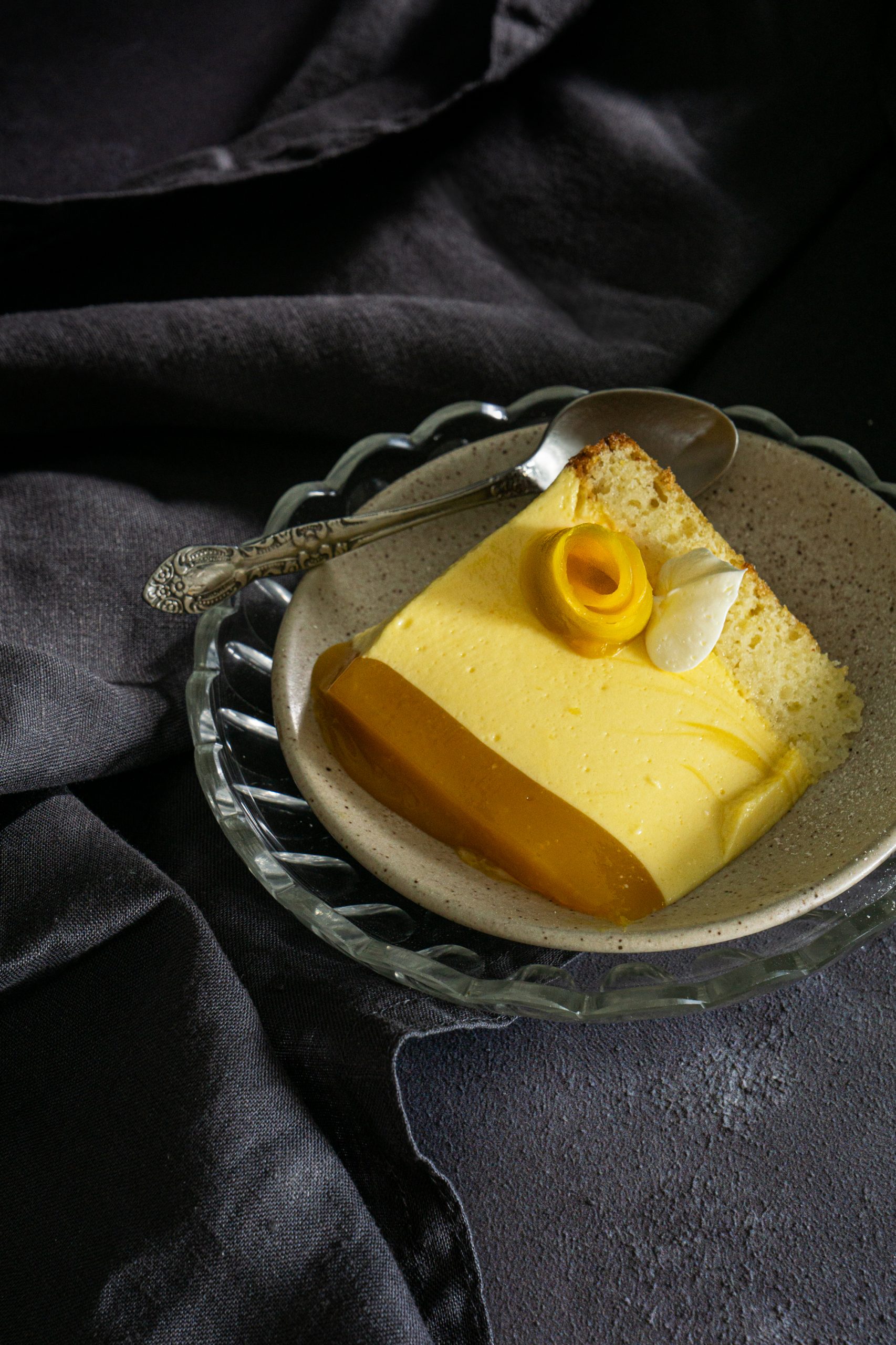
Mango Mousse Cake
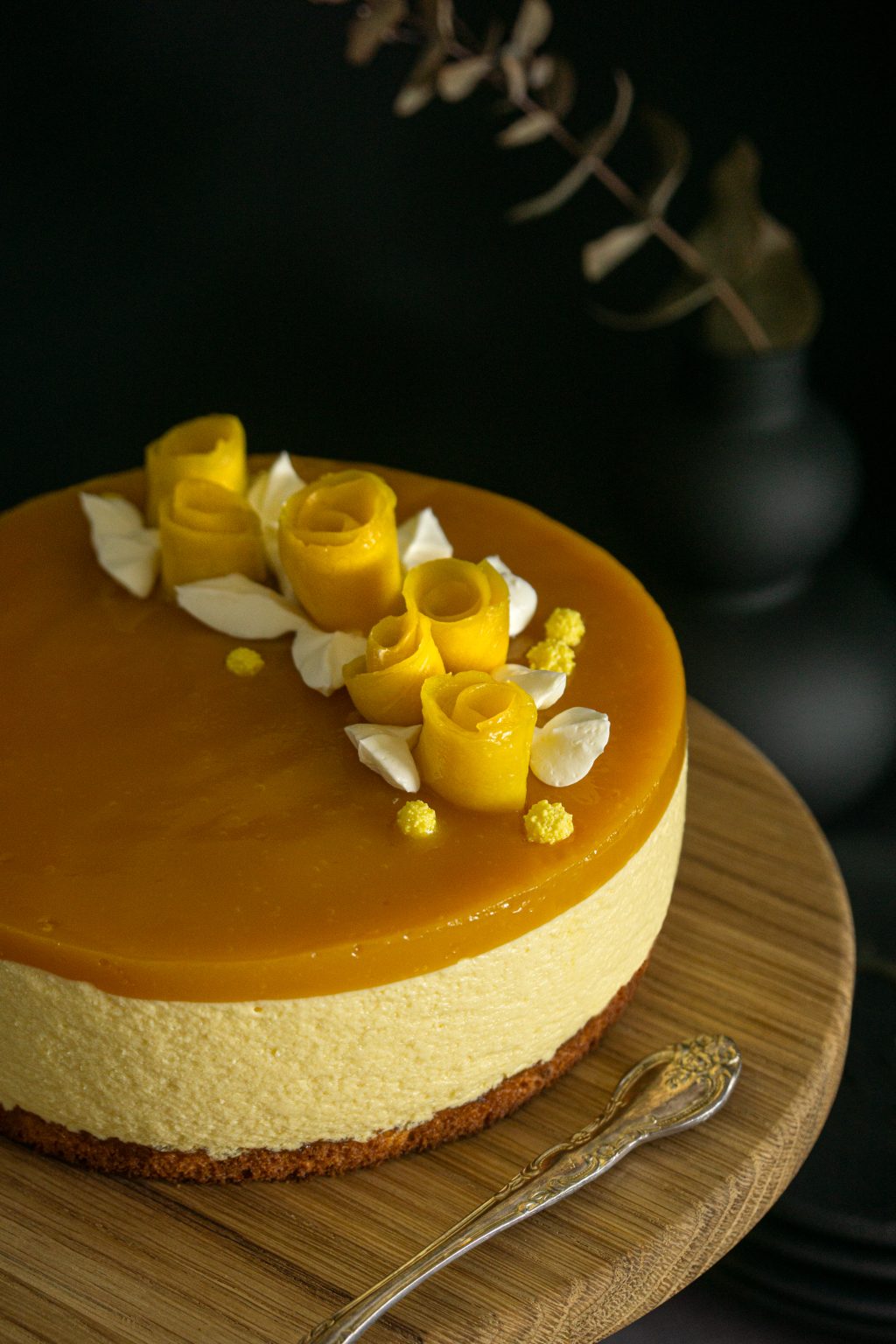
Light as a cloud, soft and creamy, full of tropical fragrance, incredibly delicious. This mango mousse cake is a true summer dream.
- Prep Time40 min
- Bake / Cook Time25 min
- Rest / Chill Time6 hr
- Total Time7 hr 5 min
- Yield10 serv.
- Cake Tin Size15 cm / 6 inch
Ingredients
Lemon Sponge Cake
- 1 medium egg (50-60 g / 1,7-2,1 oz without shells)
- 40 g / 1,4 oz granulated sugar
- 20 g / 0,7 oz unsalted butter
- 20 ml / 0,7 fl oz lemon juice
- 2 g / 0,07 oz grated lemon zest (of ½ medium lemon)
- 40 g / 1,4 oz wheat flour (cake flour or plain flour)
- ¼ tsp baking powder
- ⅛ tsp salt
Lemon Syrup
- 15 ml / 0,5 fl oz lemon juice
- 15 ml / 0,5 fl oz water
- 10 g / 0,35 oz sugar
Mango Mousse
- 125 g / 4,4 oz thick greek yogurt (4% fat)
- 125 g / 4,4 oz icing sugar
- 220 ml / 7,5 fl oz whipping cream (30-35% fat)
- 250 g / 8,8 oz mangoes (canned or fresh, peeled and pitted)
- 12 g / 0,4 oz gelatine
- 3 tbsp cold water
Mango Jelly
- 250 g / 8,8 oz mangoes (canned or fresh, peeled and pitted)
- 5 g / 0,17 oz gelatine
- 1,5 tbsp cold water
Directions
Lemon Sponge Cake
Preheat the oven to 180°C / 350°F (without a fan).
Line the bottom of the 15 cm / 6-inch cake pan with parchment paper. Leave the sides ungreased.
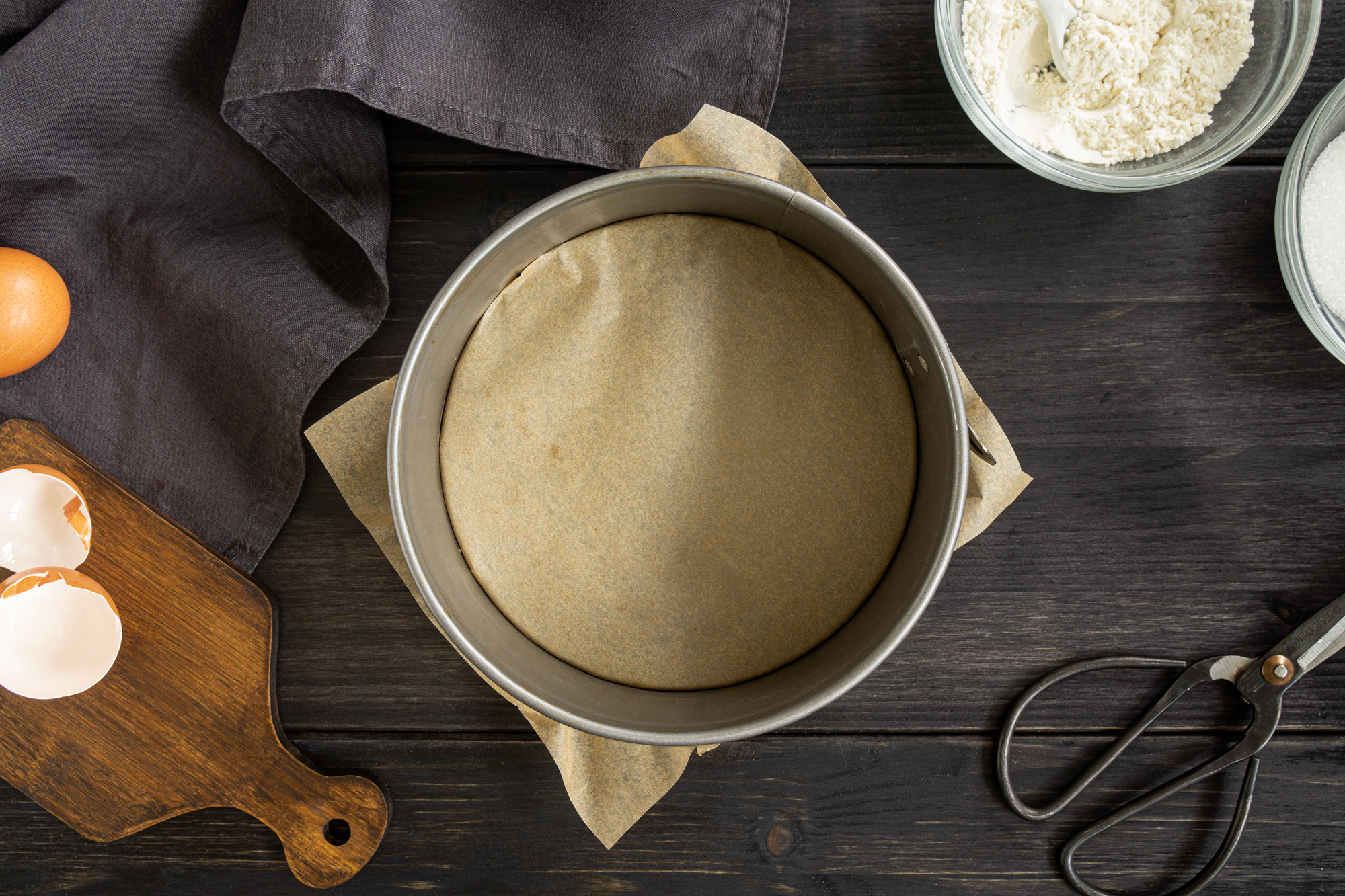
Clean the lemon thoroughly with a sponge and grate half of the zest (yellow part only). Squeeze the juice and set aside.
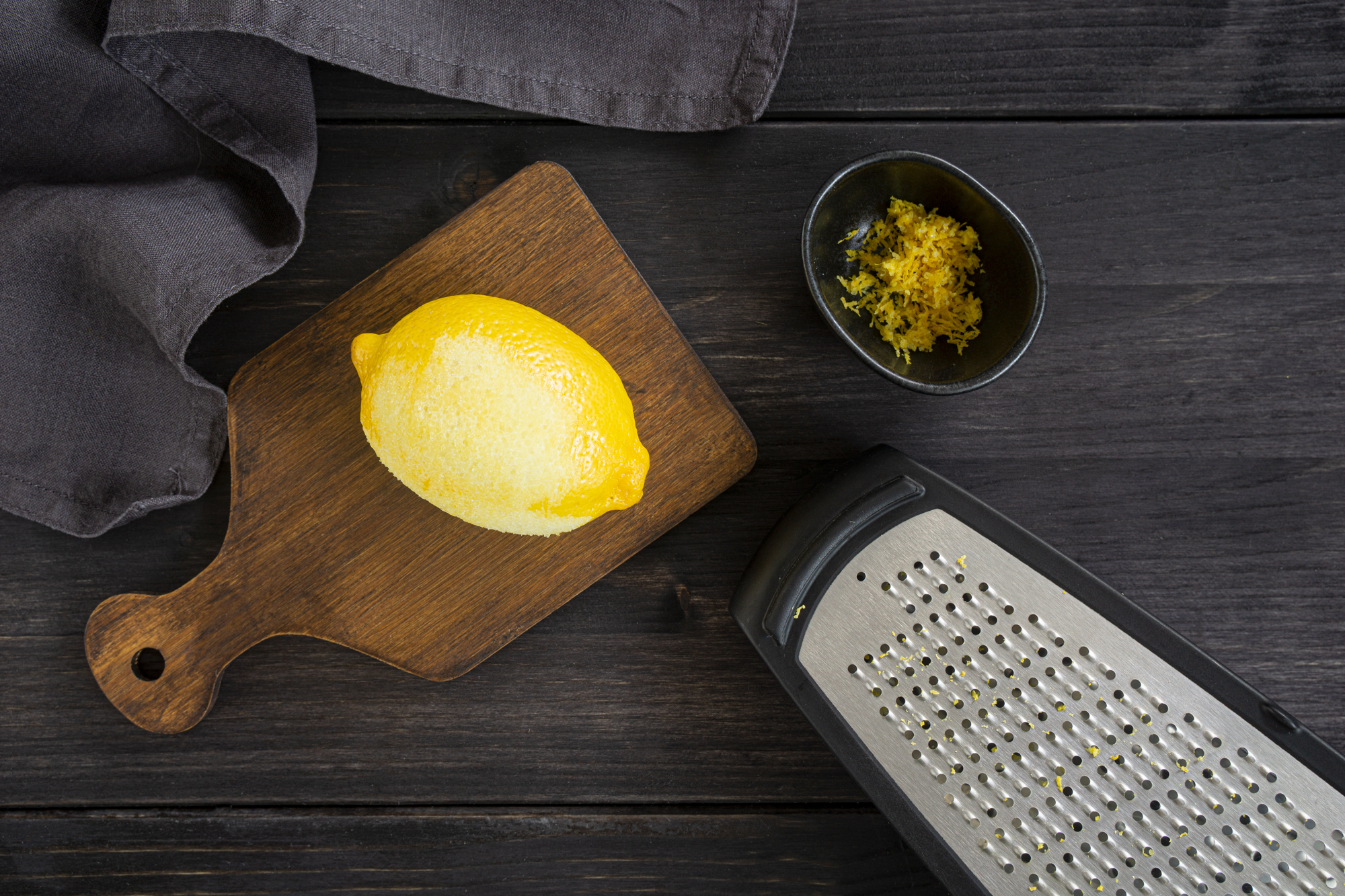
In a separate bowl, mix flour with baking powder and salt. Set aside.
On a stove on medium heat melt the butter and keep it warm till you need to use it. Do not bring to boil.
Using a handheld or stand mixer beat room temperature egg with the granulated sugar at a high speed till the mixture triples in size and gets a very pale yellow color. When you lift the whisks, the batter should fall back in thick trails which will stay on top of the batter, remaining clearly visible on the surface for at least a few moments before slowly disappearing (ribbon stage). Beating may take about 2-3 mins.
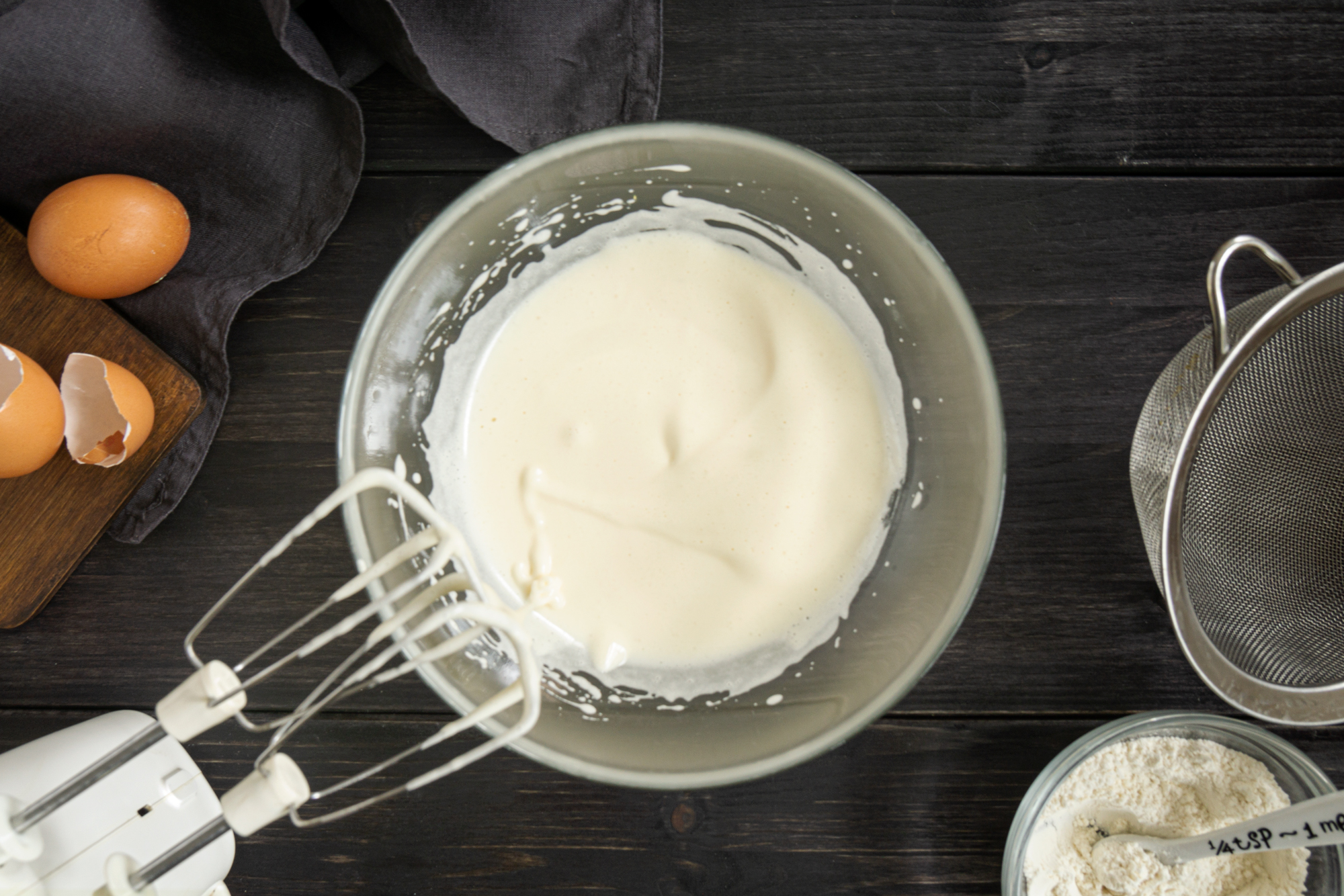
Add warm melted butter, lemon juice, and lemon zest and beat for an extra minute, till everything is well combined. The batter will get slightly thinner after this step.
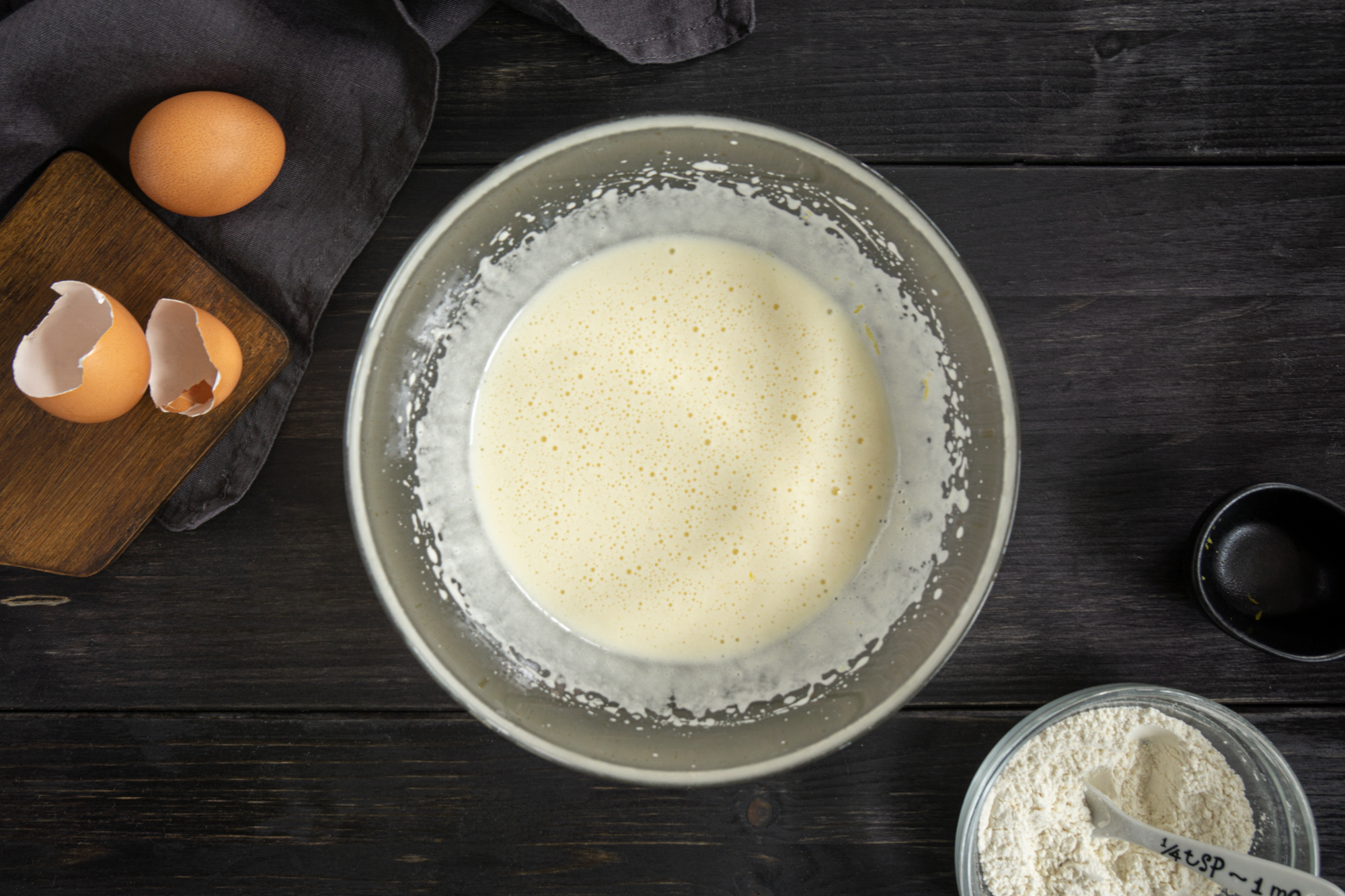
Sift the flour mixed with baking powder and salt into the batter. If you’ve beaten the egg well, the flour will sit on the top and will not sink.
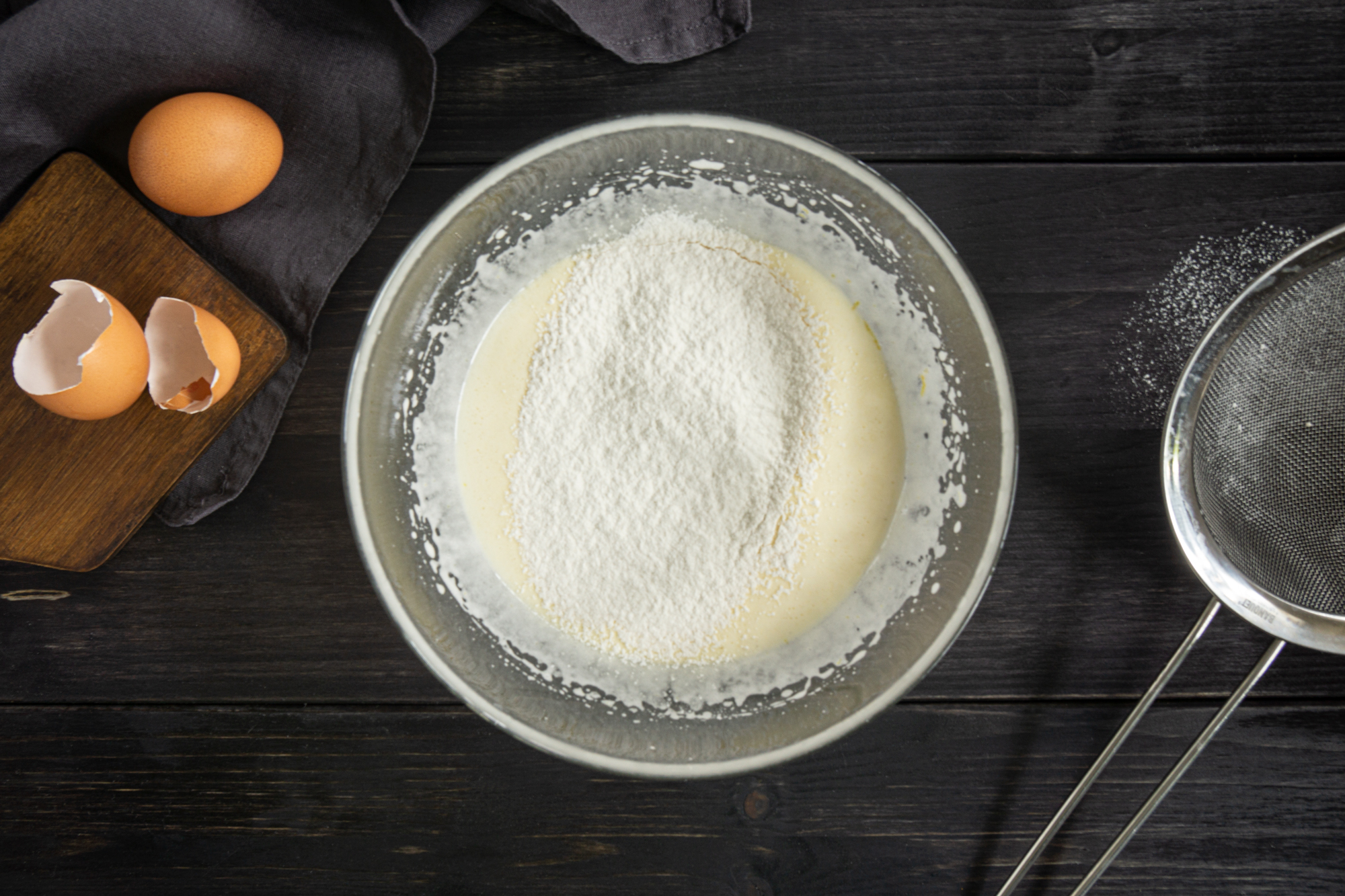
Fold in flour carefully using a silicone spatula or a spoon just until combined. Rotate the bowl all the time to remove flour pockets easier.
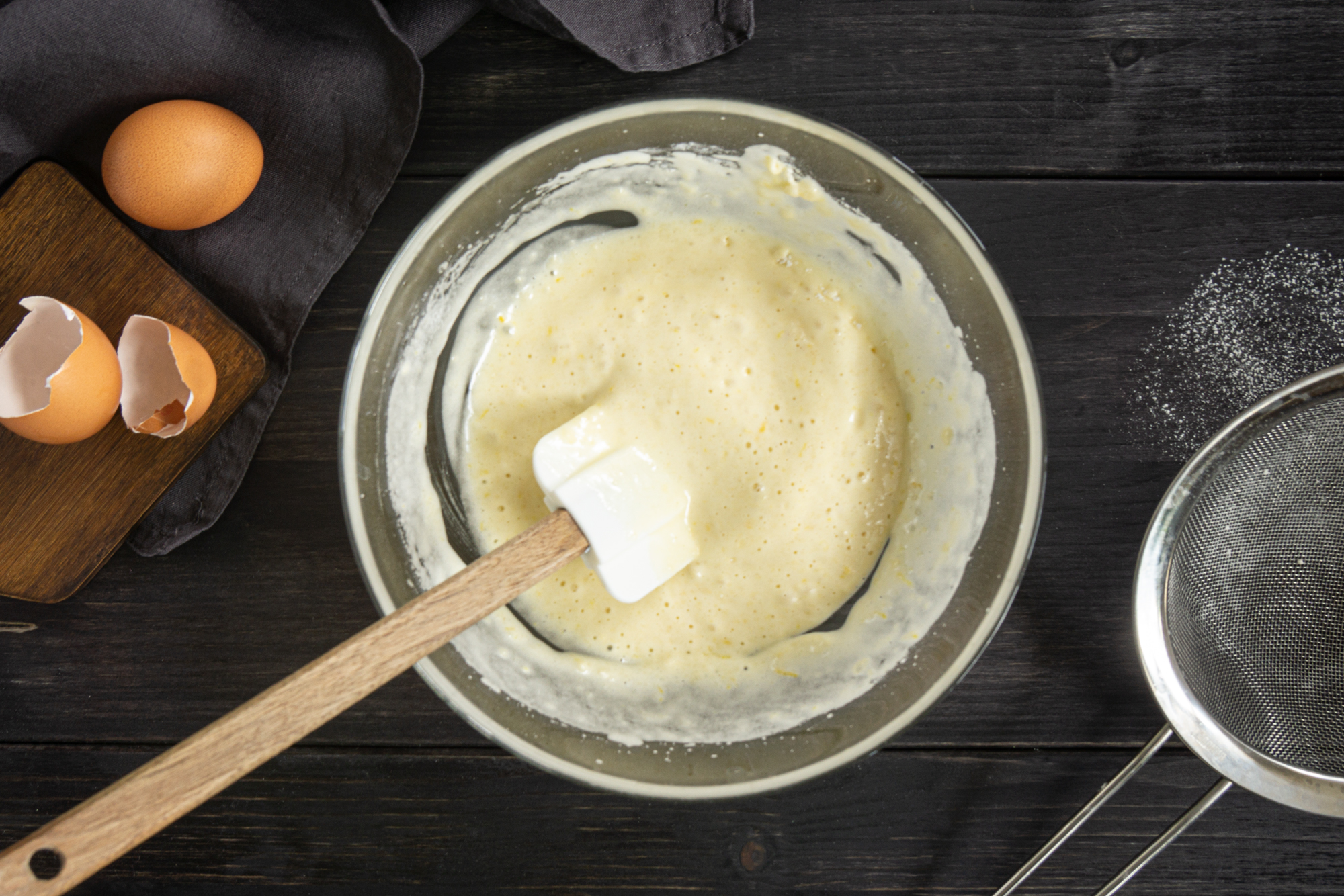
Transfer the batter to the previously prepared cake pan. Bake for 20-25 mins till the top gets slightly golden.
After taking the cake out of the oven, leave it in the pan for a few minutes. Run a table knife or a metal spatula around the pan edges, take the cake out and transfer it to a rack to cool completely.
Lemon Syrup
Mix lemon juice, water, and sugar. Stir till sugar fully dissolves. Set aside till you are ready to assemble the cake.
Mango Mousse
In a small bowl mix gelatine with cold water and set aside to bloom (5-10 mins at least).
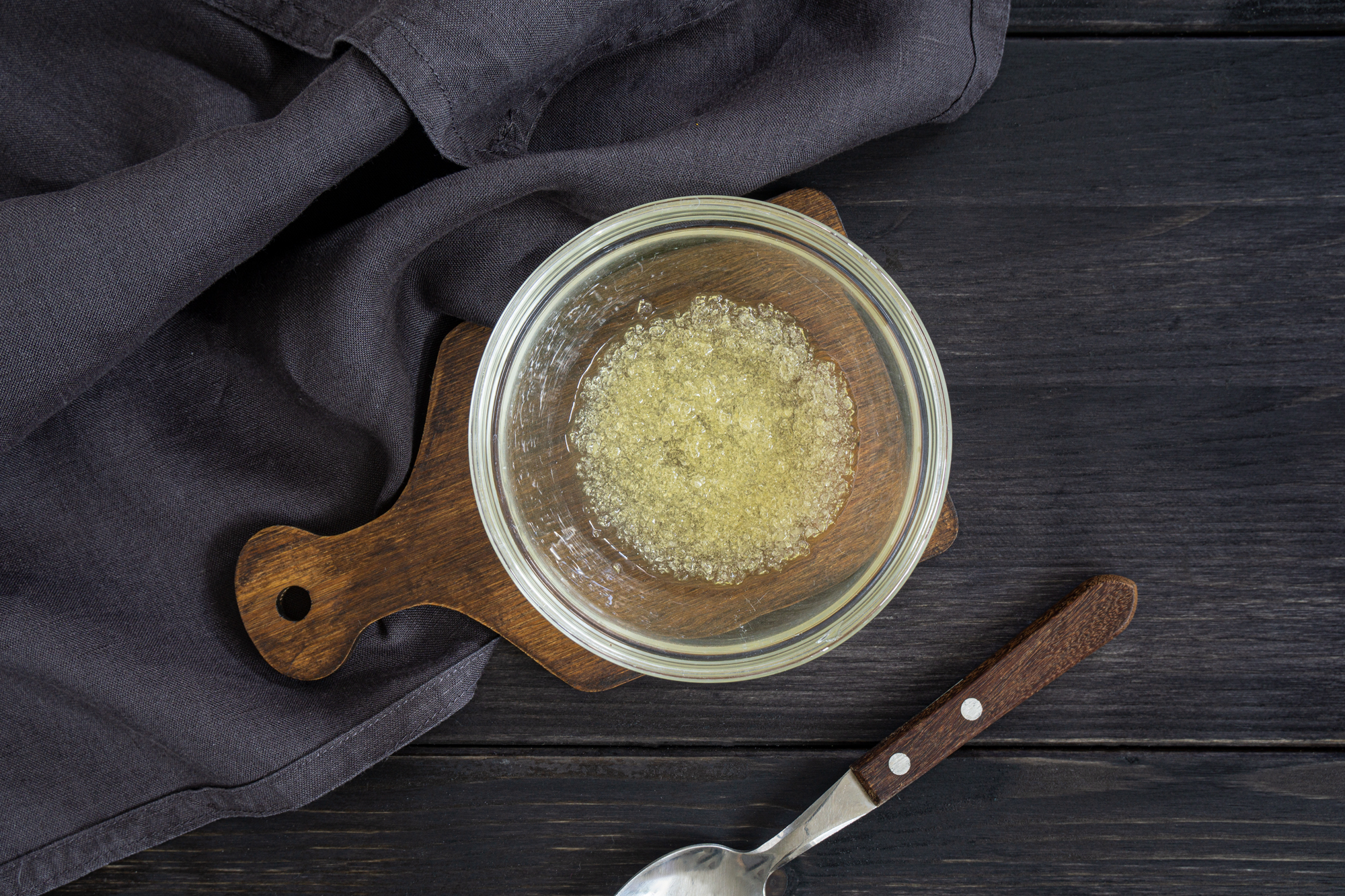
If you are using canned mangoes, drain the syrup. If you are using fresh ones, peel, cut, and remove the pit. Make sure you have 500 g / 17.6 oz of mango pieces. Using a blender or a food processor, puree mango pieces till you get an even consistency.
Strain mango puree through a fine sieve to remove any pit “hair”.
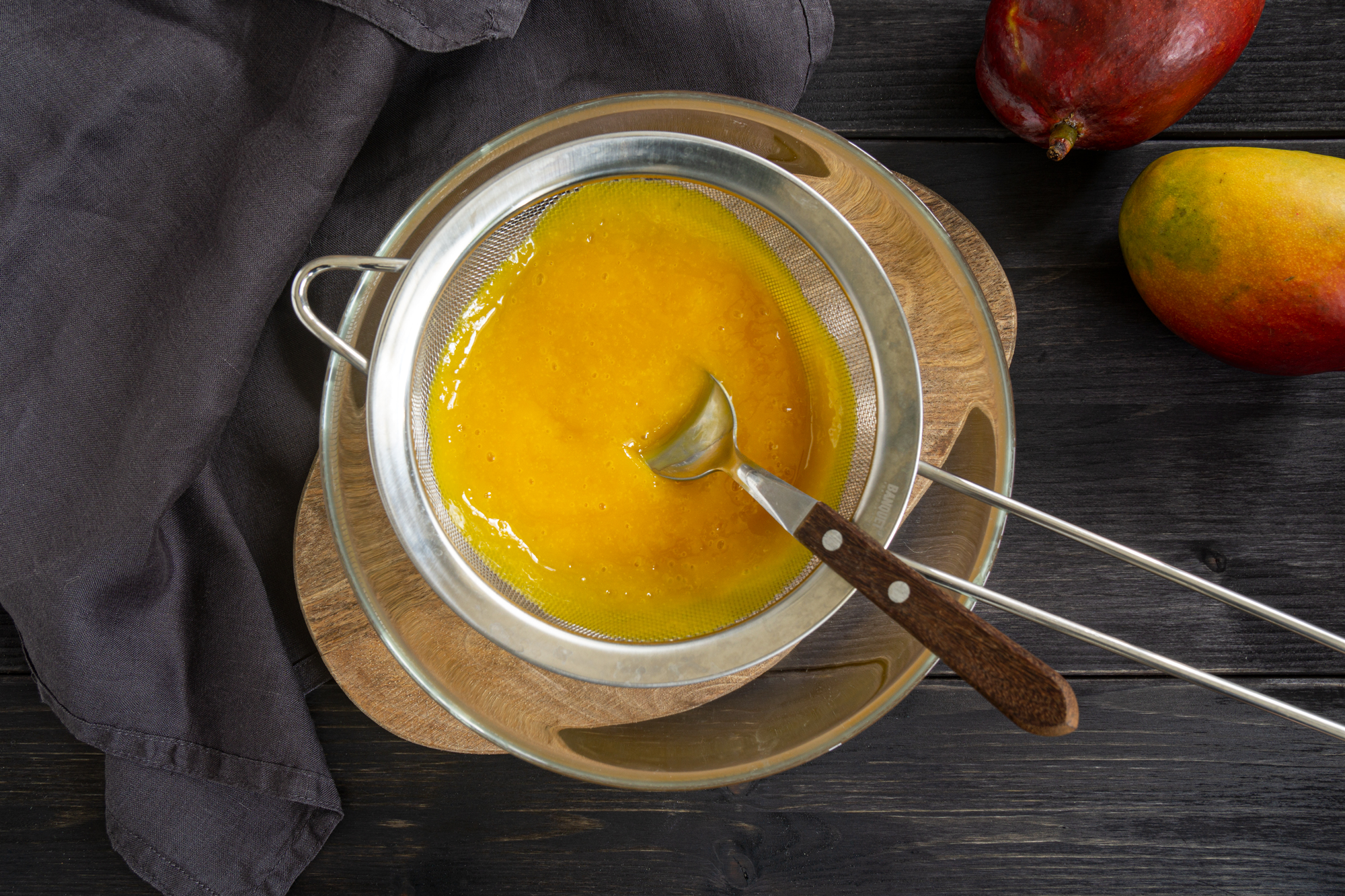
In a separate bowl mix greek yogurt and icing sugar till well combined.
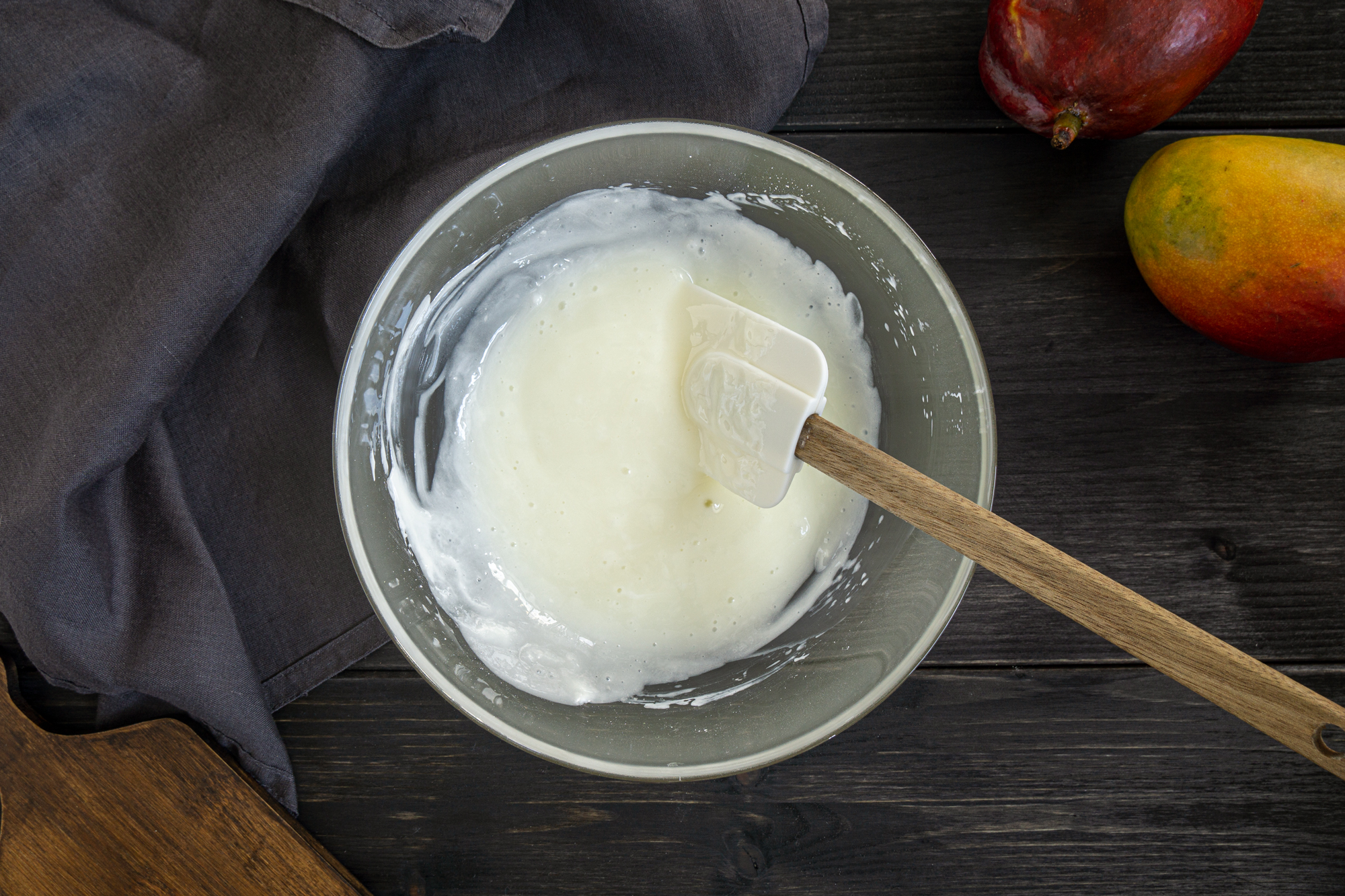
Add 250 g / 8,8 oz mango puree and mix till well combined.

Put a bowl with previously bloomed gelatine on top of the pot with steaming water making sure that the bottom of the bowl is not touching the water. Heat the gelatine just until it’s fully melted. Be careful not to overheat and do not bring to boil.
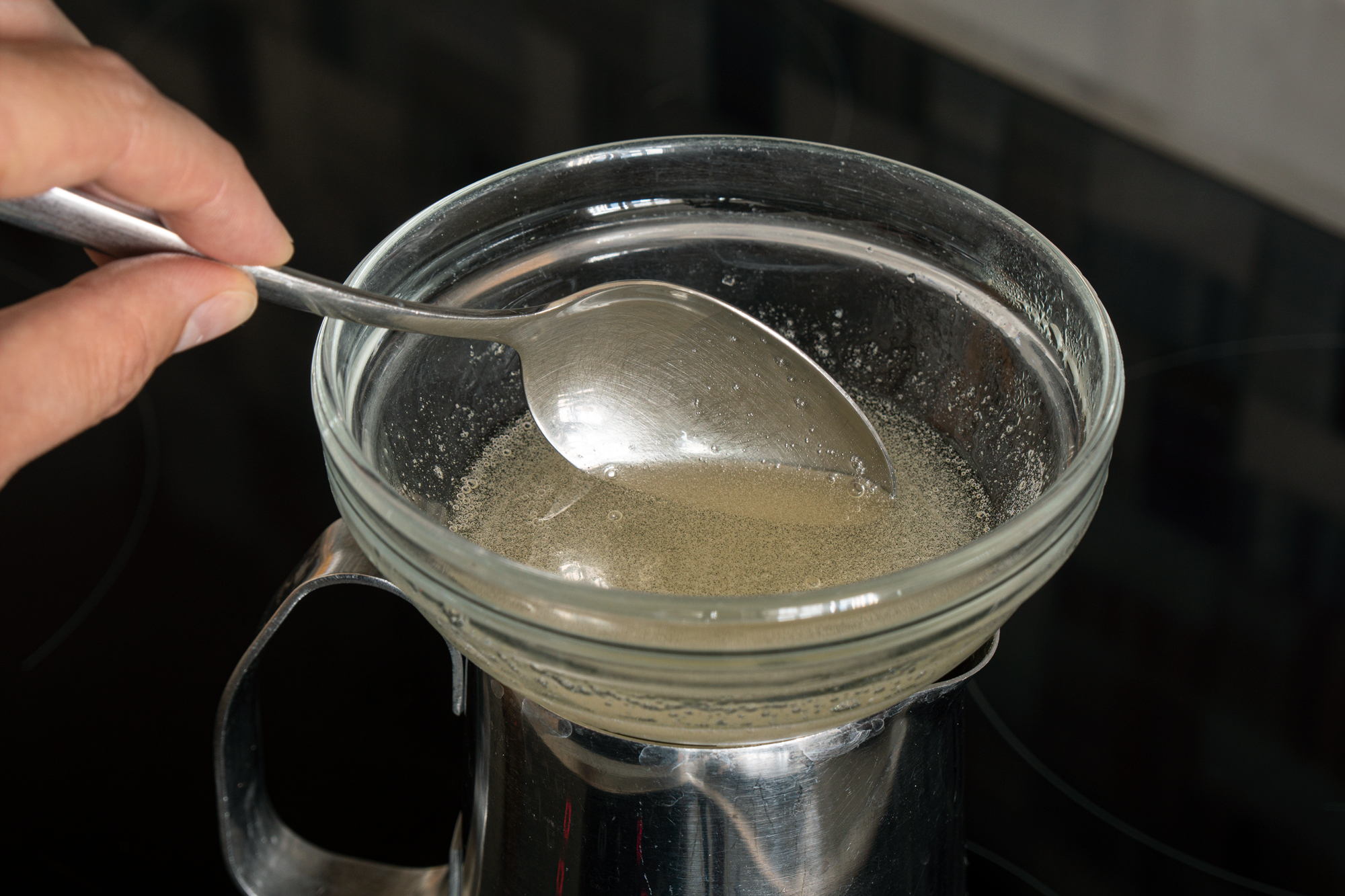
Add a few spoons of the yogurt-mango mixture to melted gelatine, mix well and pour it back into the yogurt-mango mixture. Mix everything well.
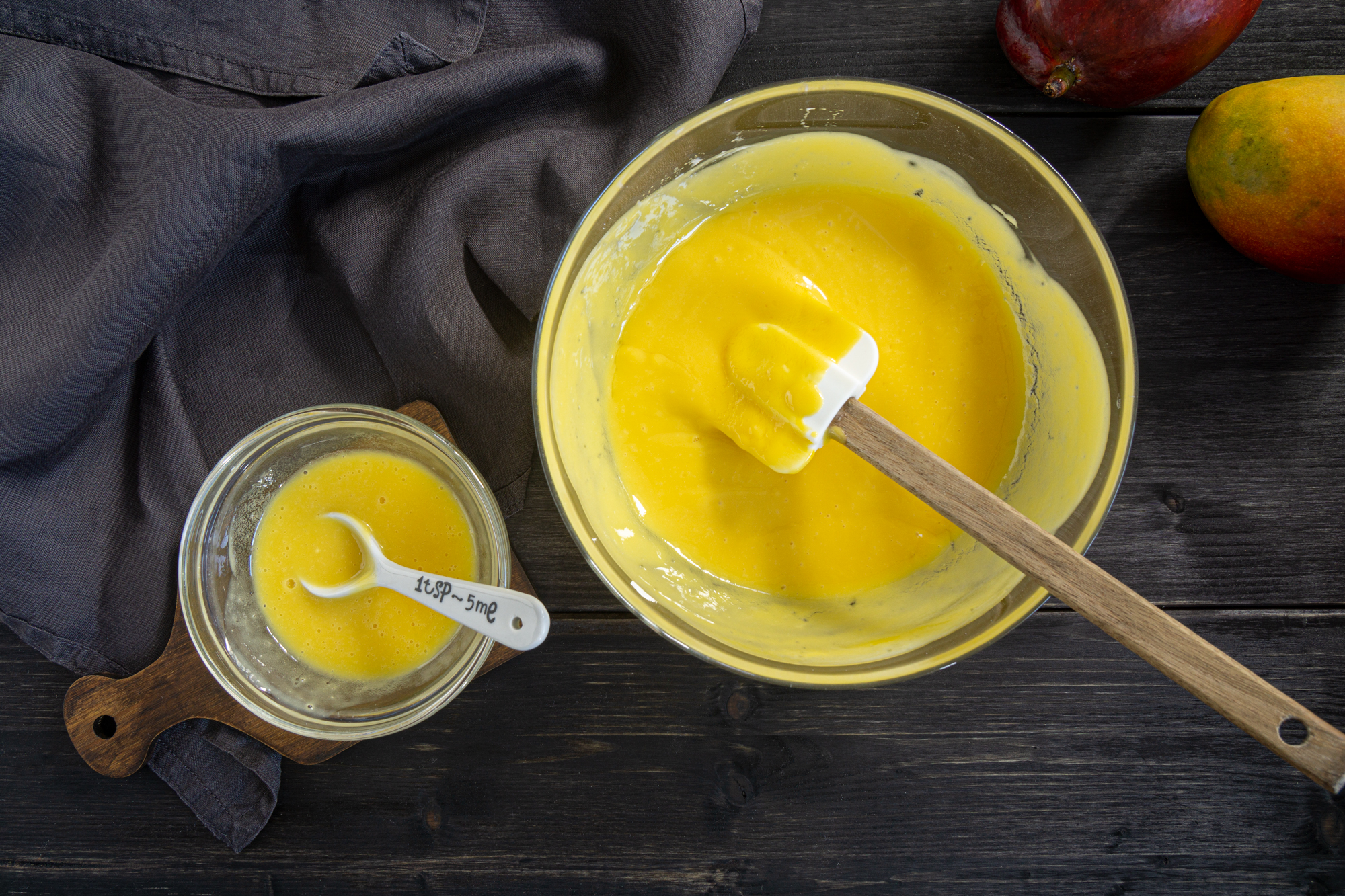
In a separate bowl, beat cold whipping cream till medium-stiff peaks form. Be careful not to overbeat.
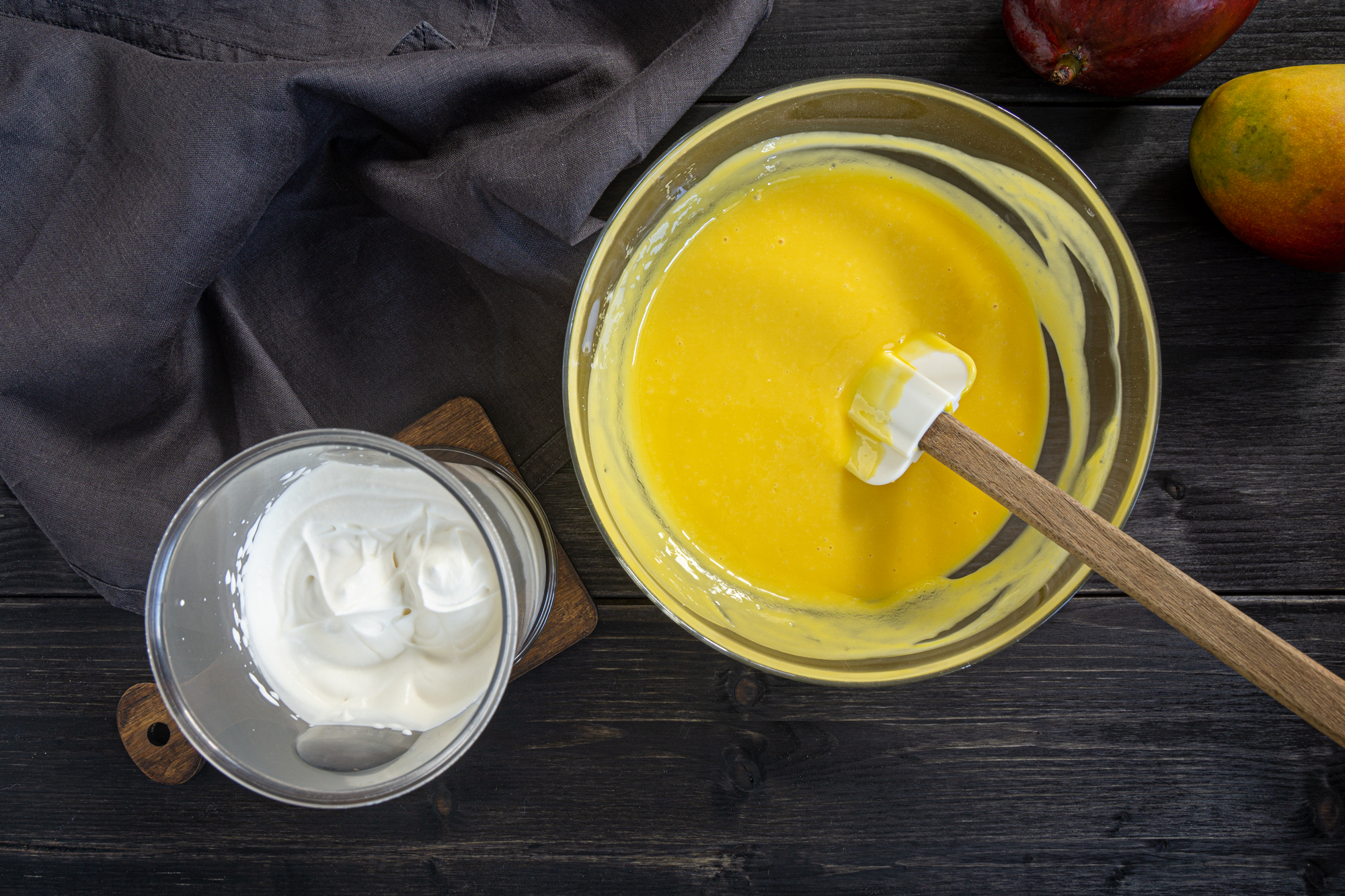
Add whipped cream to the yogurt-mango mixture and carefully fold in till everything is well combined.
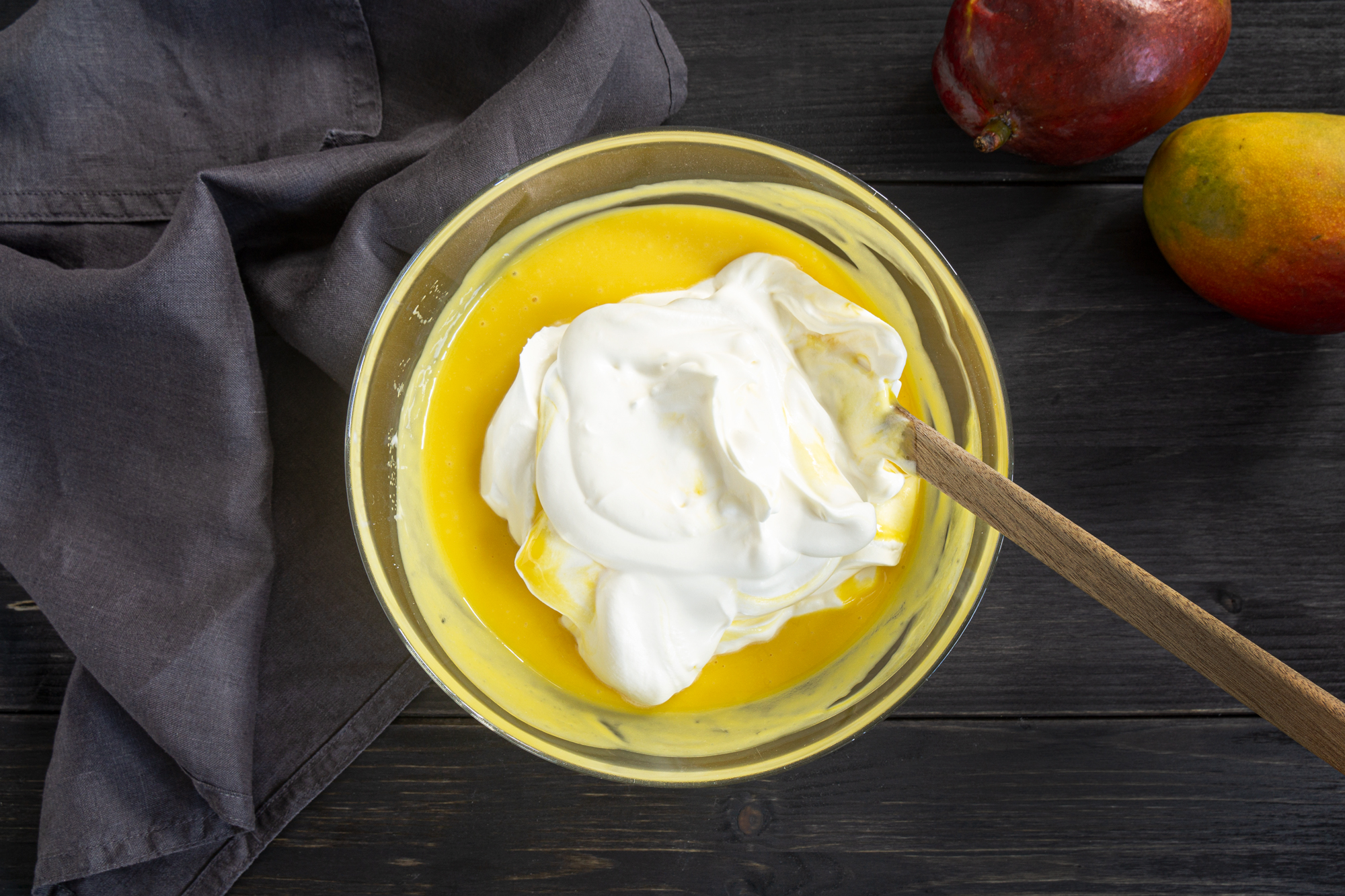
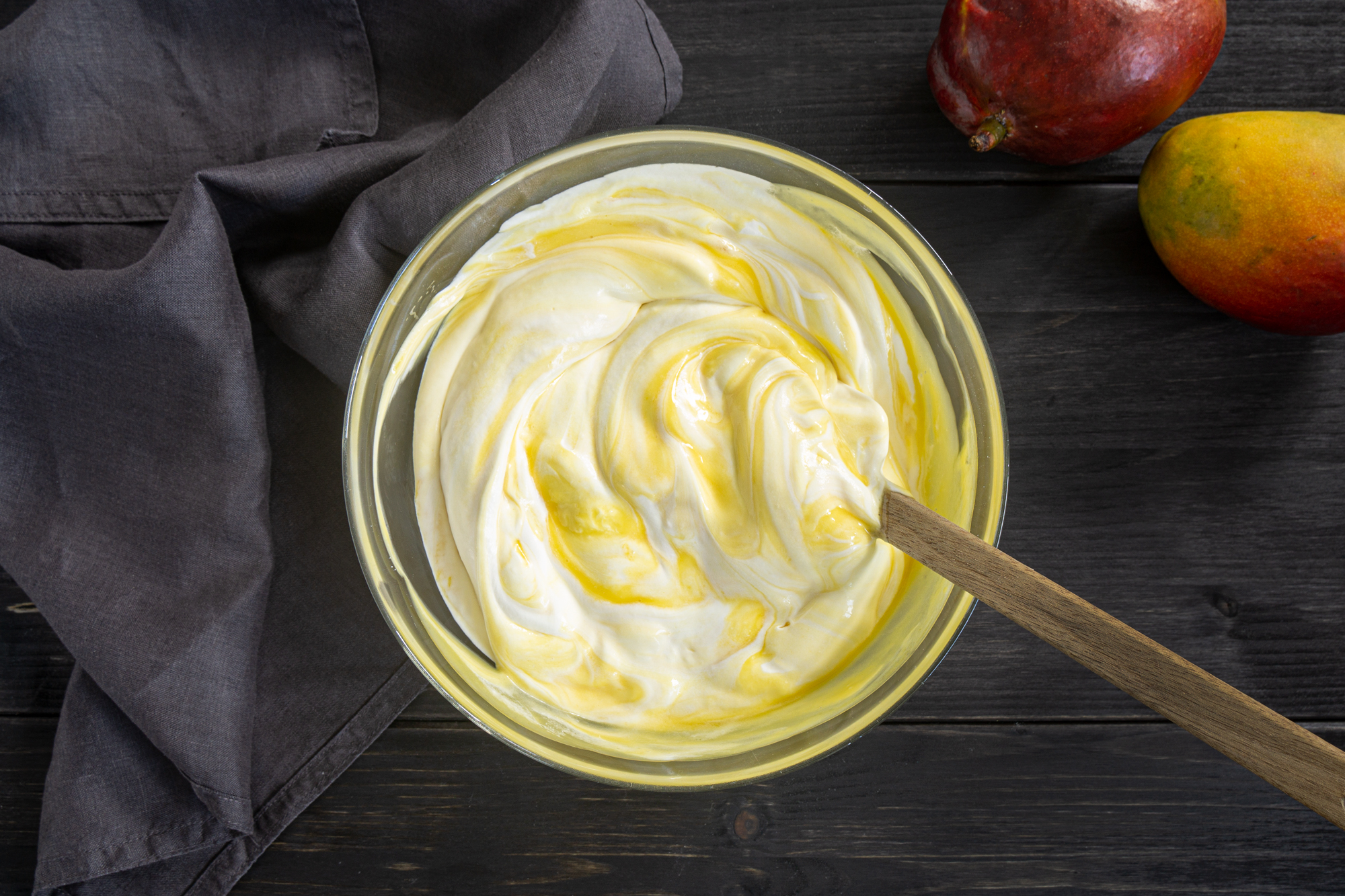
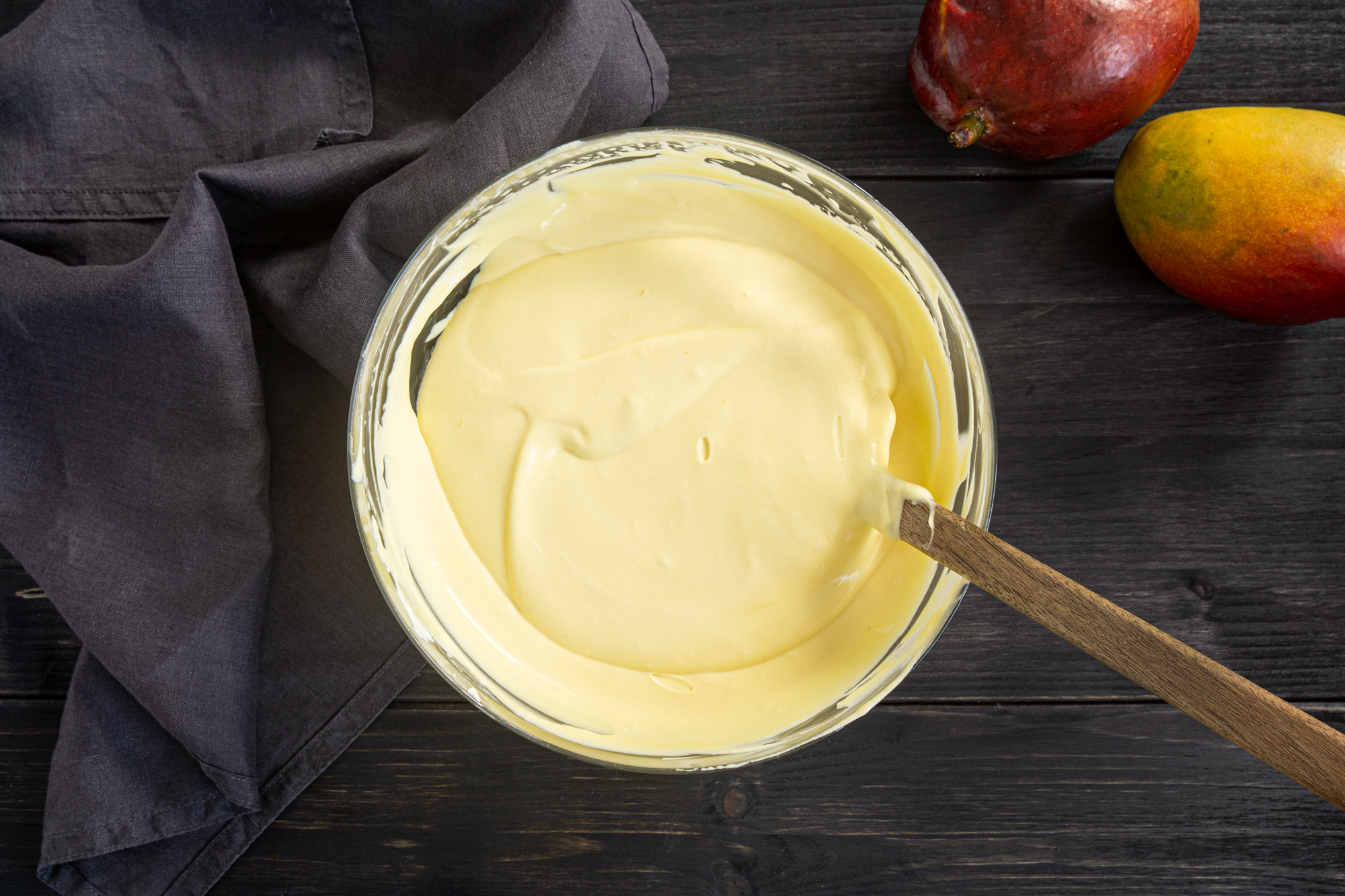
Assemble the cake
Put the cooled cake on a cake board or a flat plate. Wrap it with an acetate strip and a metal cake ring.

Soak the cake with lemon syrup you’ve prepared before. I do this simply using a spoon.
Spread the mango mousse on top of the cake layer and level the top.
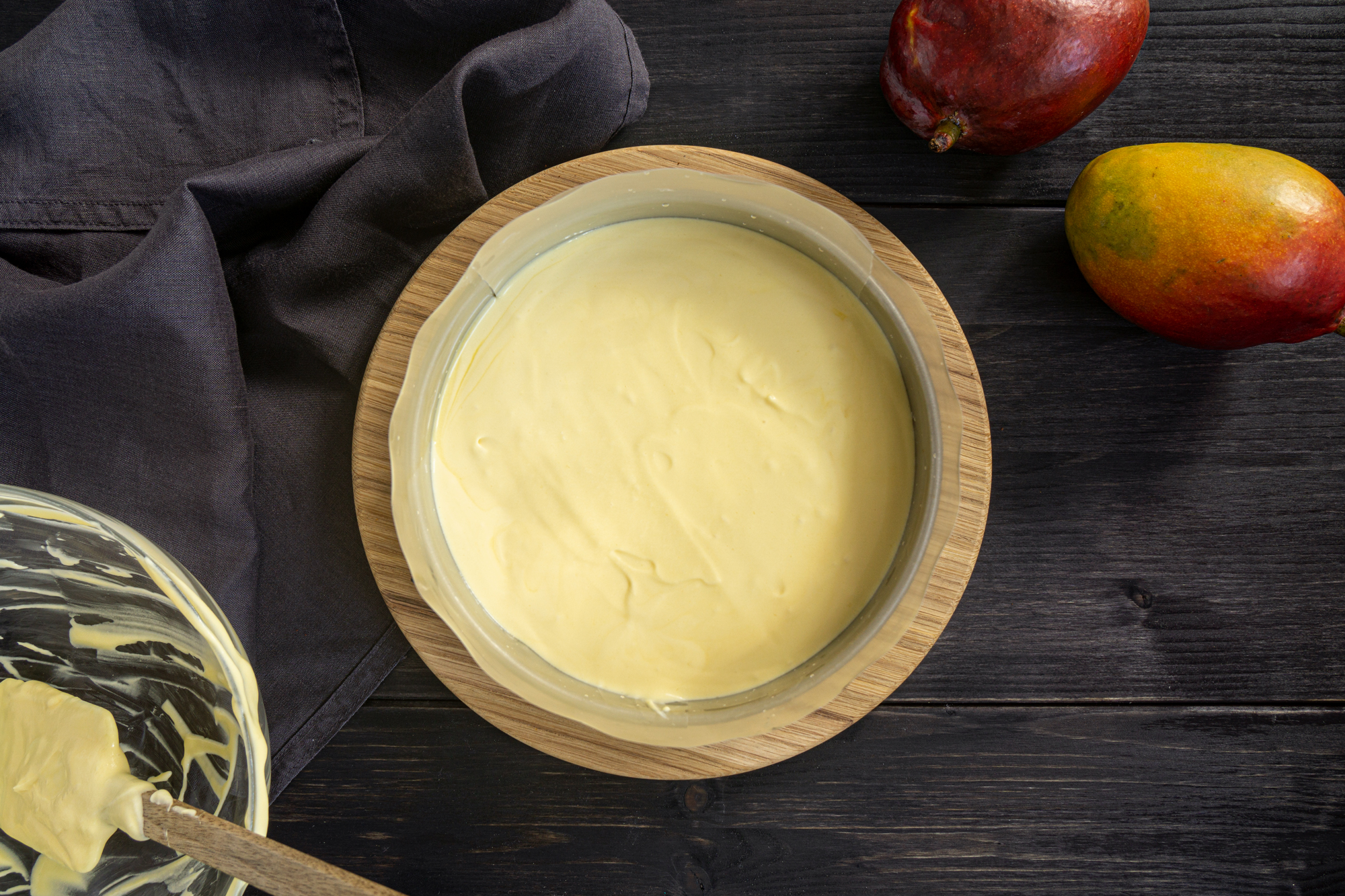
Chill the cake in the fridge for 1-2 hours till the mousse starts to set.
Mango Jelly
Bloom and melt the gelatine following the same process described before.
Mix the melted gelatine with the remaining 250 g / 8,8 oz of mango puree.
Pour mango puree on top of the mousse layer. Do this very carefully, because mousse is not yet fully set.
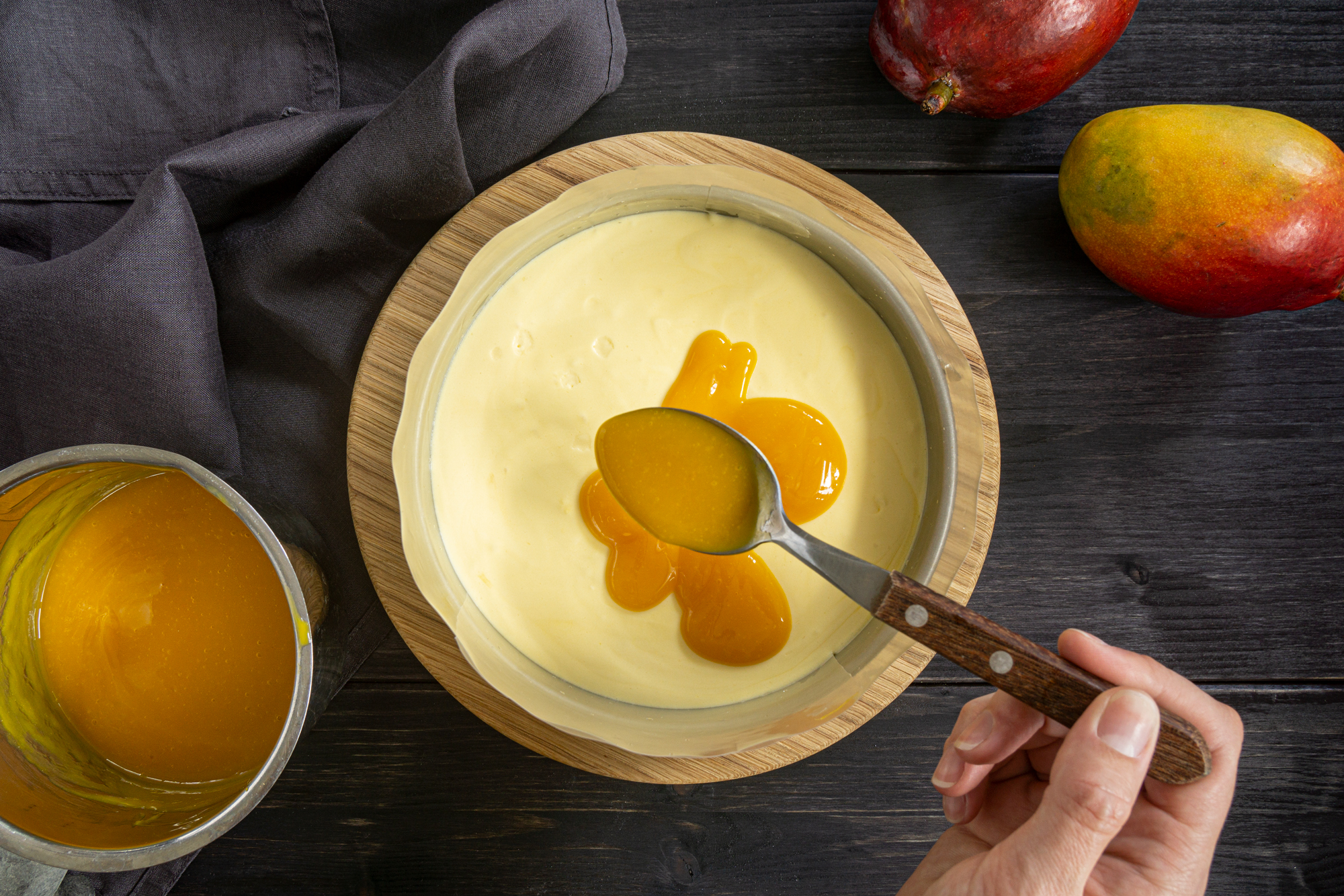
Carefully level the top.
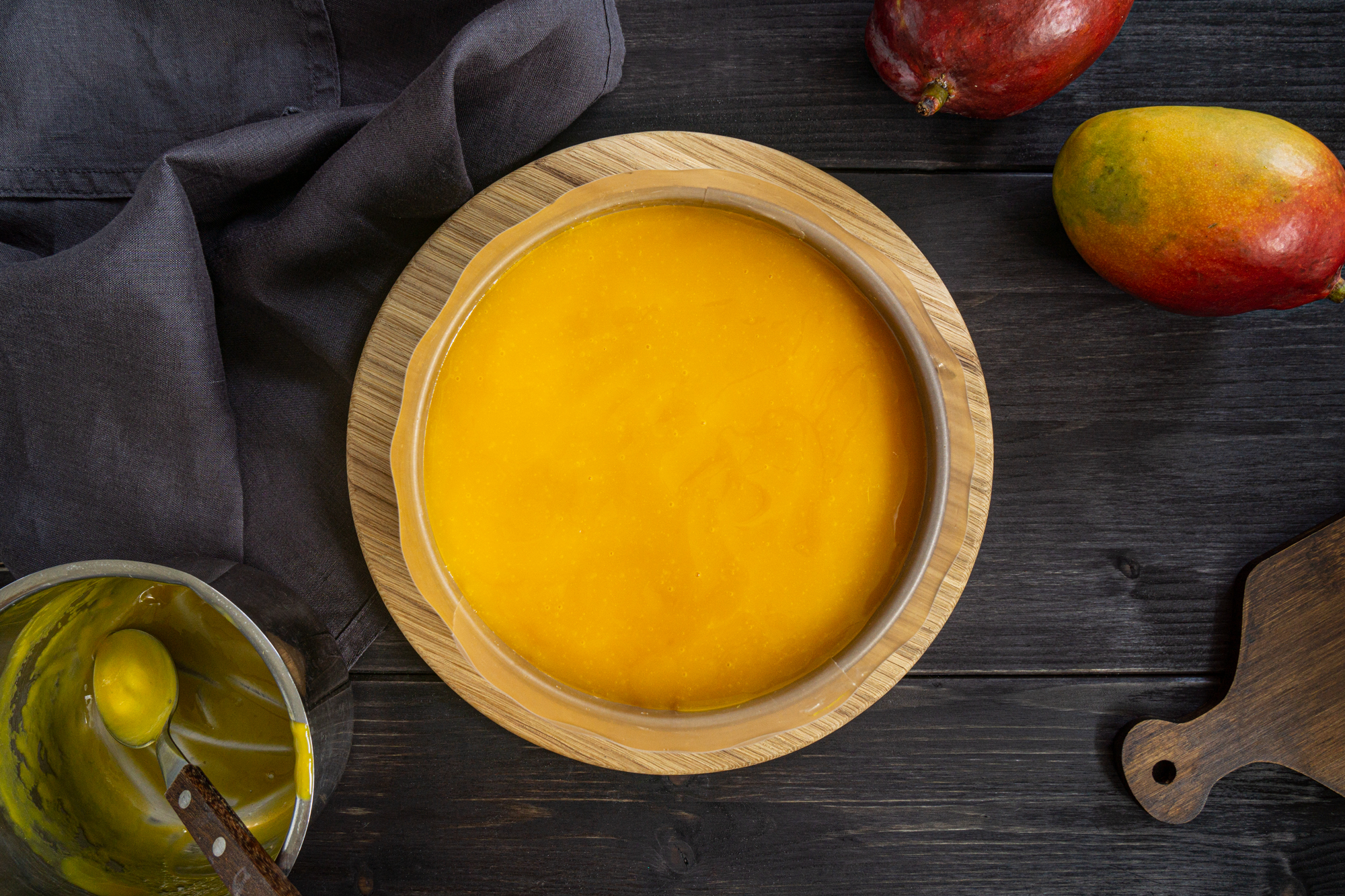
Chill the cake in the fridge till the jelly slightly sets but it is still partly soft (up to 1 hour). Decorate the top to your liking. I used roses made of fresh mango slices and buttercream leaves. When jelly will set further, it will lock decorations in place. It depends on how you decorate, but if you try to do it after the jelly is fully set, decorations will most likely slide off.
Chill the cake in the fridge for at least 5 hours or overnight till it’s fully set. Carefully remove the metal ring and acetate strip before serving.
notes
- By any means, do not skip the step of straining mango puree. Mango pits are “hairy” and even if you are using professionally prepared and canned mangoes, some of those “hair” will get into your puree. I’m 100% sure. And you don’t want any hair in your cake. I’m 100% sure about this too.
- I had different experiences using different gelatine brands. So check the manufactures advice on the package to make sure how much you need for the cake. Mousse in the recipe equals approx 600 ml / 20,3 fl oz of the liquid and mango puree for the jelly – approx 250 ml / 8,45 fl oz of the liquid.
- If you don’t have acetate strips, you can use parchment paper when assembling the cake. Remove parchment paper extra carefully after the cake has set.
